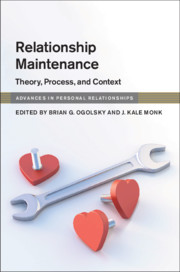Book contents
- Relationship Maintenance
- Advances in Personal Relationships
- Relationship Maintenance
- Copyright page
- Contents
- Tables
- Figures
- Contributors
- Part I Introduction
- Part II Theories of Relationship Maintenance
- Part III Processes of Relationship Maintenance
- 7 Communication and Relationship Maintenance
- 8 Attributions, Forgiveness, and Gratitude as Relationship Maintenance Processes
- 9 Social Networks and Relationship Maintenance
- 10 Dyadic Coping as Relationship Maintenance
- 11 Conflict Management and Problem Solving as Relationship Maintenance
- 12 Sex as Relationship Maintenance
- 13 Accuracy and Bias in Relationship Maintenance
- Part IV The Social Context of Relationship Maintenance
- Part V Conclusion
- Index
- References
10 - Dyadic Coping as Relationship Maintenance
from Part III - Processes of Relationship Maintenance
Published online by Cambridge University Press: 02 December 2019
- Relationship Maintenance
- Advances in Personal Relationships
- Relationship Maintenance
- Copyright page
- Contents
- Tables
- Figures
- Contributors
- Part I Introduction
- Part II Theories of Relationship Maintenance
- Part III Processes of Relationship Maintenance
- 7 Communication and Relationship Maintenance
- 8 Attributions, Forgiveness, and Gratitude as Relationship Maintenance Processes
- 9 Social Networks and Relationship Maintenance
- 10 Dyadic Coping as Relationship Maintenance
- 11 Conflict Management and Problem Solving as Relationship Maintenance
- 12 Sex as Relationship Maintenance
- 13 Accuracy and Bias in Relationship Maintenance
- Part IV The Social Context of Relationship Maintenance
- Part V Conclusion
- Index
- References
Summary
Perhaps not surprisingly, romantic couples experience stress. Stress can originate both within the relationship, such as differing viewpoints between partners, or outside the relationship, such as learning about a poor performance review at work or having an argument with a friend. Irrespective of the origin of the stress, romantic partners are able to combat its negative effects by recognizing stress as an interdependent experience, one that is shared between partners, and engaging in positive dyadic coping. Conceptualized by Bodenmann’s systemic transactional model, positive dyadic coping is defined as supportive behaviors that help to downregulate partners’ negative experiences of stress and include providing emotional or problem-focused support. The purpose of this chapter is to present compelling evidence to conceptualize positive dyadic coping as a relationship maintenance strategy, one that helps preserve the relationship during times of distress and contributes to relationship satisfaction and longevity.
Keywords
Information
- Type
- Chapter
- Information
- Relationship MaintenanceTheory, Process, and Context, pp. 178 - 193Publisher: Cambridge University PressPrint publication year: 2019
References
Accessibility standard: Unknown
Why this information is here
This section outlines the accessibility features of this content - including support for screen readers, full keyboard navigation and high-contrast display options. This may not be relevant for you.Accessibility Information
- 9
- Cited by
